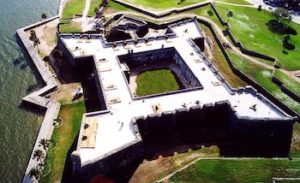
*The Castillo de San Marcos began construction on this date in 1672.
Built with Black African and Native American slave labor, it is the oldest masonry fort in the continental United States. Still standing, it is located on the western shore of Matanzas Bay in the city of St. Augustine, Florida. The city of St. Augustine was founded for the Spanish Crown in 1565 on the site of a former Native American village called Seloy.
The need for fortifications was recognized after it was attacked by Sir Francis Drake and his fleet of 22 ships in 1586, and over the next 80 years, nine wooden forts were built in various locations along the coastline. However, after a 1668 attack by the English pirate Robert Searle, during which the town of St. Augustine was burned to the ground, wooden forts were deemed inadequate, and Mariana, Queen Regent of Spain, approved the construction of a masonry fortification to protect the city. The Castillo is a masonry star fort made of stone masonry, which consists of ancient shells that have bonded together to form a sedimentary rock similar to limestone.
The Castillo was designed by the Spanish engineer Ignacio Daza, and construction began 107 years after the city's founding by Spanish Admiral and conquistador Pedro Menéndez de Avilés when Florida was part of the Spanish Empire. Native Americans, African slaves brought in from Havana, Cuba, did most of the labor. Construction lasted twenty-three years, with completion in 1695. When Britain gained control of Florida in 1763 under the Treaty of Paris, St. Augustine became the capital of British East Florida, and the fort was renamed Fort St. Mark until the Peace of Paris (1783) when Florida was transferred back to Spain and the fort's original name restored. In 1819, Spain signed the Adams Onís Treaty, which ceded Florida to the United States in 1821; consequently, the fort was designated a United States Army base and renamed Fort Marion.
Under the United States control, the fort was used as a military prison to incarcerate members of Native American tribes, starting with the Seminole, including the war chief, Osceola, in the Second Seminole War, and members of western tribes, including Geronimo's band of Chiricahua Apache. The Native American art form known as Ledger Art originated at the fort during the imprisonment of members of the Plains tribes, such as Howling Wolf of the southern Cheyenne. The fort was declared a National Monument in 1924 and, after 251 years of continuous military possession, was deactivated in 1933. The 20.48-acre site was subsequently returned to the United States National Park Service.
In 1942, an Act of Congress restored Castillo de San Marcos's original name. Castillo de San Marcos was attacked several times and twice besieged. However, possession of the fort has changed six times, all peacefully, among four different governments. Since the transfer to the National Park Service in 1933, it has been a popular tourist destination.